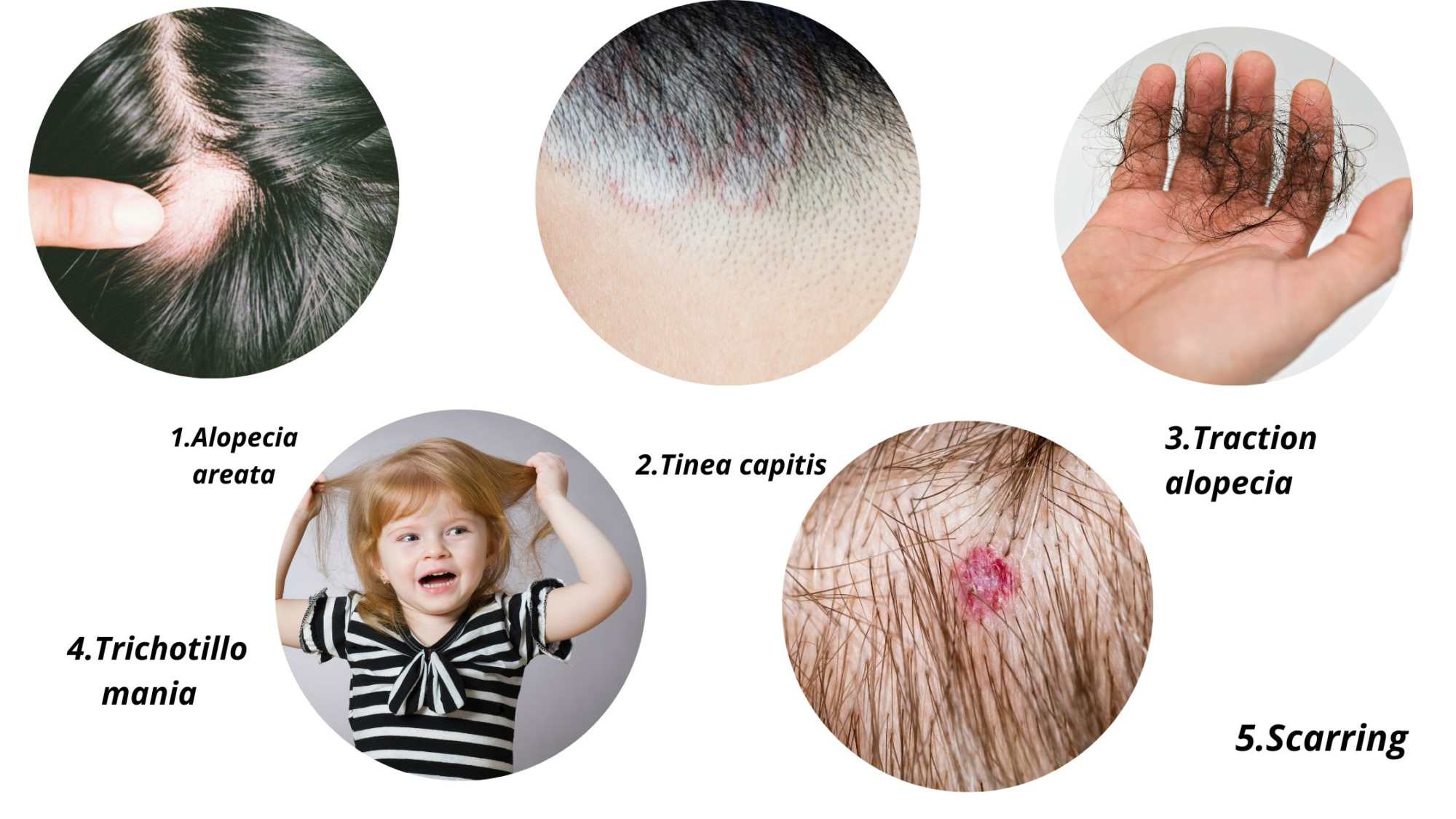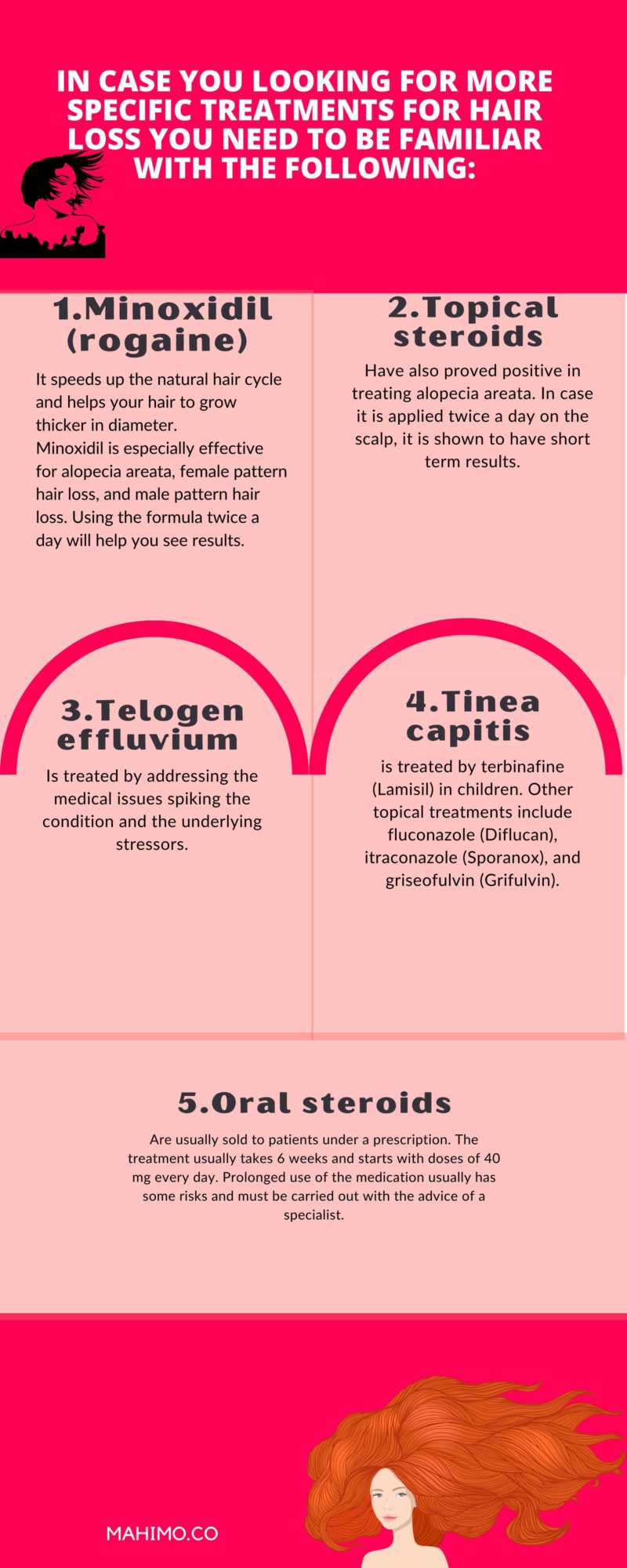101 Signs and Symptoms of Hair Loss in Men and Women and How to Stop them
101 Signs and Symptoms of Hair Loss
Oh, no! I’ve gone bald overnight! How is it that everybody else grows hair in only a few days and never loses any?
Hmm … can you believe that? Because even though you might have heard it a lot, neither the claim nor the question is actually correct. Nobody loses hair overnight (well except if you burn your hair), nor does hair grow back in an unnoticeably short time.
There are always signs and symptoms of hair loss to look for. Are you wondering why you never notice? The answer is within your question. Pay attention. Also, there are specific signs of different types of hair loss. We have listed the most common signs here. The third sign for men and the first one for women are more common.
And, don’t worry, once you learn how to trace the symptoms in men and women, you will also learn about the available and effective treatments for preventing and curing hair loss. Hair loss symptoms for women.
Content
Hair loss symptoms for men
Male pattern hair loss (MPHL), also referred to as male pattern baldness (MPB) or androgenic alopecia (AGA), can be diagnosed with 5 simple primary symptoms.
1. Sudden hair loss after showering or brushing hair
If patches of hair fall while showering, brushing your hair, or simply by touching, then it’s a sign of excessive hair loss.
Take note that we lose hair every day. It’s a normal physiological function and you can expect a few strands of hair fall every time you brush your hair or take a shower. But in case the amount of hair loss suddenly feels heavier, you need to take action.
2. Gradual thinning of hair
This pattern manifests with loss of hair on top of the head, around the temples, and back of the head. It happens over the course of time, so you should expect to see the hair on top of your head become scanter. A receding hairline is one of the common types of hair thinning.
3. Receding hairline
One of the common symptoms of hair loss with men is the receding hairline around the forehead.
A receding hairline can happen both in men and women. The thinning becomes apparent in the crown of your hair and near the sides of your forehead. This is especially manifested with an M-shaped pattern appearing on men’s forehead.
If you take consecutive pictures of your forehead over the course of time and compare the pictures with each other, the change will be more evident.
4. Circular bald patches
In medical terms, this condition calls Alopecia Areata. It can appear as single or multiple bald patches in the scalp, eyebrows, beard, eyelashes, and body hair. Another sign that may help you identify the condition is the rapid shedding of hair in the affected areas.
The patterns of hair loss may vary in different cases. It can happen in circular patches, network patterns, and bandlike patterns on the front or sides of the head. In severe cases, alopecia areata can result in complete loss of hair on the head or the body.
5. Full Body Hair Loss
Sometimes, hair loss may occur in all areas of the body. This is usually instigated by factors such as chemotherapy or the use of a specific medication.
Hair loss symptoms for women
1. Thinning of the Scalp
In women, the most common sign of hair loss is thinning of the scalp. In this case the hair on top of the head, over the sides, and on the crown falls. As a result, the forehead feels broader, and the hair feels scanter across the head.
2. Receding Hairline
Just like men, hair loss can cause the hairline across the forehead recede. In women, this symptom appears as a forehead that feels broader, rather than an M-shaped pattern.
3. Widening Part
Another early sign of hair loss is the widening of the part on your hair. Pay attention to your part, does it feel wider? Monitor the area for a while to see if any changes occur there. You can also open a part on another area of your head, and trace the pattern of hair fall there as well.

What are the common hair loss conditions?
Let’s get more scientific. According to American Family Physicians, hair loss may occur in different ages, spiked by different causes. What you see as a pattern of hair fall tells a lot about your type of hair loss and its causes. It goes without saying that the treatment you receive also relies on this.
The two main categories of alopecia are diffuse and focal. Each is categorized into different conditions in turn:
Diffuse
1. Female pattern hair loss
AFP lists hair thinning as a characteristic of this type of alopecia. However, the hairline in the front remains intact and there is a negative pull test away from areas with hair loss. Wondering what’s pull test? Scroll down to How to diagnose hair fall.
2. Male pattern hair loss
This is characterized by thinning of the hair, M-shaped hairline around the forehead, and a negative pull test away from the areas struck with hair loss.
3. Diffuse alopecia areata
In this condition, there is a patchy distribution of baldness and a positive pull test.
4. Alopecia totalis or universalis
As the name suggests, this case is characterized by a total loss of hair on the scalp and the body. Unfortunately, less than 10% of patients recover from this type of hair loss.
5. Telogen effluvium
The condition is caused by a precipitating factor that causes a large number of hairs to enter the resting phase of hair growth (telogen). Three months after the initial effect, around 30 to 50 percent of the hair starts falling and the hair responds positively to the pull test.
Telogen effluvium can be caused by a variety of factors, such as hyperthyroidism, hypothyroidism, iron deficiency, anemia, severe illness, drugs, injury, surgery, crash diets, anxiety, and infection. Even so, in one third of cases, the causes of hair loss remain unrevealed.
6. Anagen effluvium
According to AFP, the condition occurs two weeks after chemotherapy, when 90% of the hair falls.
In this condition, the hair which is in the growing phase of hair cycle, called anagen, stops growing.

Focal Nonscarring
1. Alopecia areata
In this type of hair loss, the scalp appears normal. However, the hair takes an exclamation point shape.
This means a thinned proximal shaft is extracted from a club shaped root, but is extended to its normal caliber on the distal shaft.
The condition can happen in both men and women.
Many patients experience it before turning 20, meaning it occurs mostly among children and young adults. While there is a percentage of historical background as for the cause of the condition, it usually occurs in individuals with some form of autoimmune disease.
2. Tinea capitis
If potassium examination of the scalp reveals fungus with a scaly scalp, then chances are your condition can be categorized as a focal nonscarring case called tinea capitis. A round patch of hair loss, “often with scaling, erythema, and lymphadenopathy”, is symptomatic of this condition.
Tinea capitis often occurs among children, and according to AAFP, it is usually caused by microsporum species.
3. Traction alopecia
This condition is manifested by patchy hair loss, usually caused by beauty procedures and hair practices. There might also be some kind of scarring in the area of hair loss.
The culprits in this type of hair loss are stressors from the outside that can cause traction and pressure on hair follicle. For example, individuals who use curling rollers, wear wigs, style their hair with tight braids, or frequently use processes like bleaching and coloring are usually at risk.
It often occurs in the frontotemporal area of the head and is diminished when the stressor is eliminated.
4. Trichotillomania
Patchy hair loss with the possibility of some scarring is visible in this case. The condition may also cause psychological disturbance.
Trichotillomania often occurs as a result of habitual hair plucking among children, but may also continue to adulthood. Usually, as a result of constant plucking, the hair gets twisted or broken.
5. Scarring
- In this atrophy of the scalp, some signs of scarring are visible. As a result of autoimmune or inflammatory diseases, the hair follicles get damaged and cause permanent hair loss.

Hair Loss Causes and Risk Factors
Losing hair in women can occur due to anxiety, a deficiency of minerals or as a result of certain diseases and hormonal disbalances. In this line we can mention:
- Iron deficiency
- Protein or vitamin deficiency
- Thyroid disease
- Syphilis
- Fungal infection
- Stress or trauma
- Hyperandrogenism

Caused by factors such as
- Infertility
- Unresponsive cystic acnes
- Hirsutism
- Abnormal menses
- Virilization
- Galactorrhea
AAFP asserts that approximately 50% of men above the age of 50 experience hair fall. Hair loss in men is mainly associated with Dihydrotestosterone. This happens when the androgen sensitive follicles get damaged and cause bitemporal recession.
Then the hair in the vertex and frontal regions of the head start thinning and cause an M-shaped pattern of hair fall. As such, male hair loss is also usually associated with psychological issues such as depression and low self-confidence.
How to Diagnose Hair Fall
You can have a preliminary diagnosis of hair loss depending on the symptoms that you observe. You can begin by determining if your hair loss is categorized as focal or diffuse. In case you see some scarring in focal hair loss, you need to refer to a doctor.
If it is non-scarring and focal, then you may be able to determine the case with this method:
- Alopecia areata: look for damages that are round in shape and feel smooth.
- Tinea capitis: the scalp gets flaky and feels erythematous.
- Traction alopecia: patchy hair loss is what you need to look for.
- Trichotillomania: patchy hair loss is a symptom of this condition too. You may also like to pay attention to your history of hair loss.
If you can tell that your type of hair loss is diffuse, then you need to consider the type of hair loss as thinning or shedding. The presence or absence of itching, anemia, thyroid disease, and hyperandrogenism are also important signs to look for.
In case you experience gradual thinning of hair, then you should be worried about a male or female pattern of hair loss. But if you see hair shedding, chances are your condition is alopecia areata (especially if your hair resembles the exclamation point that we explained above) or telogen effluvium (especially if there is a history of illness).
A positive hair pull test is one of the effective tests in determining unnatural hair loss. You need to hold 40 to 60 strands of hair between your thumb and forefinger, and slightly apply pressure on your scalp while sliding your fingers along your hair.
According to AAFP, if the amount of hair pulled out in this fashion is less than 10 percent, there’s nothing to worry about. But greater amounts indicate the existence of some kind of pathologic issue.
In areas of the scalp struggling with hair thinning, hair pull test is positive, but it is negative in areas with no signs of hair thinning. As for hair shedding, the hair pull test is positive in both telogen effluvium and alopecia areata.
In case you observe signs other than mere hair shedding, then you need to see a doctor.
Doctors diagnose alopecia areata with just examining your hair and scalp. In case of complications, a doctor may examine hair under microscope, perform skin biopsy or a blood test to look for factors such as fungal infection or autoimmune diseases.
Treatment
As you see, hair loss can stem from a variety of conditions, and treatments may vary accordingly. They also depend on factors such as age, gender, environmental factors, psychological state, and ethnicity.
Even though some forms of hair loss are likely to recur over the course of life, treatments can often help regrow lost hair.
Generally speaking, the positive results of treatments can start to show from 6 to 12 months from the time you start the treatment.
However, you also need to consider the fact that certain states in the body can interfere with the effectiveness of the treatments and their duration. So, you need to address issues in your body, if any, and make sure to bring your hair loss treatment into a harmony with your condition.
Another point to bear in mind is that treatments can cause side effects. So, you need to consult a specialist before picking up a treatment.
Treatments fall into 4 main groups:
- Topical agents
- Injections
- Light therapy
- Oral medication
In case you are looking for more specific treatments, you need to be familiar with the following:
1. Minoxidil (Rogaine) is one of the most common topical treatments for hair loss.
It speeds up the natural hair cycle and helps your hair to grow thicker in diameter.
Minoxidil is especially effective for alopecia areata, female pattern hair loss, and male pattern hair loss. Using the formula twice a day will help you see results.
Another factor you need to remember is that you can find minoxidil with different dosages.
While a 1% formula might help an individual, another person might need a 5% formula. Your specialist will determine this according to your own special case.
2. Topical steroids have also proved positive in treating alopecia areata.In case use twice a day on the scalp, it is shown to have short term results.
3. Topical retinoids are another type of topical treatment use for alopecia areata.
4. Oral steroids usually sold to patients under a prescription. The treatment usually takes 6 weeks and starts with doses of 40 mg every day.
The use of the medication usually has some risks and must be advice of a specialist.
5. Finasteride (Propecia) is one of the effective treatments for male pattern hair loss. This medication induces hair growth over the course of 2 years. However, effects tend to diminish with the third year. Prescriptions usually require daily use of finasteride with a dose of 1 mg.
But what about conditions other than alopecia areata, MPHL, and FPHL? The history of treatments suggested for other hair loss conditions is as follows:
6. Tinea capitis treat terbinafine (Lamisil) in children. Other topical treatments include fluconazole (Diflucan), itraconazole (Sporanox), and griseofulvin (Grifulvin).
7. Traction alopecia is mainly caused by an outside stressor. So, eliminating the stressor can stop hair loss. In addition to this, the condition can be reversed with 2% minoxidil.
8. Telogen effluvium is treated by addressing the medical issues spiking the condition and the underlying stressors.
9. Female pattern hair loss can be easily stopped with 2% minoxidil. However, it might not show the desired results in women with a hyperandrogenic state.
Some of the prescribed treatments for women who have some type of hyperandrogenic state include spironolactone (Aldactone), and antiandrogenic progesterone such as drospirenone.
10. Male pattern hair loss is effectively addressed with 2% or 5% minoxidil formulas, and finasteride. However, you need to know that if you stop using minoxidil after a while, the positive changes will be reversed. Also, using finasteride can cause sexual impotence, ejaculation disorders, and decreased libido in some men.
Tips to prevent hair loss
Timing is important in preventing hair loss. Especially if you have a family history, then you need to start early In case your hair loss , you just need to be patient, dig into the roots of the issue and fix it as soon as possible.
Some general tips include:
- Eliminate outside pressure on your hair and be gentle with it. This means avoiding tight buns, frequent ironing and coloring, hair wigs, and any other factors that can stress your hair follicles.
- Reduce your stress levels. Spend some time for relaxing and practicing mindfulness every day.
- Get 7 to 8 hours of sleep every night. This will allow your body enough time for repairing and making the most of its capacities. This will remarkably facilitate hair growth.
- Maintain general hygiene. The oil produced by your scalp can get in the way of hair growth by blocking your pores and even causing hair loss. Use a gentle shampoo that is suitable for the type of your scalp and doesn’t cause irritation.
- Drink more water, because hydration is necessary for your skin and hair. Hydration is essential for your follicles to thrive. Also, molecules of water make up a large part of your hair shaft. I believe now you can imagine what inadequate hydration can do to your hair.
We suggest you read this article as well: 10 Ingredients to Avoid in Health and Beauty Products
And more general tips include:
- Keep a healthy diet. The benefits of a healthy diet for your skin and hair really need a comprehensive post. But for the sake of an introduction, your body needs all the essential nutrients for optimal performance. But you should avoid food unhealthy such as the ones containing excessive fats, salts, and carbohydrates. Instead, increase your intake of raw vegetables and fresh herbs which help your metabolism and eliminate toxins from the body.
- Avoid chemical processes such as coloring and perming. You can use natural alternatives instead.
- Stop smoking. Smoking can reduce the circulation of oxygen in your body. This is while your scalp needs oxygen to let your hair grow. As a result, your hair will weaken and become fragile.
- Massage your scalp. Massaging can increase and facilitate the flow of blood and circulation of oxygen to your hair follicles and help hair growth.
- Besides the tips mention above, you may also like to know about the procedures that perform to prevent hair loss. Two commonly practiced and talked about processes are red laser therapy and mesotherapy.
- Red laser therapy stimulates epidermal stem cells. It is especially useful for people with genetic hair loss or those who have received chemotherapy.
- One of the popular methods used for preventing and treating PHL and AGA is mesotherapy. The process includes the injection of substances into the scalp which can induce hair growth. This substances, which are also called cocktails, contain a mixture of “natural plant extracts, homoeopathic agents, vitamins, vasodilators, and drugs that may stimulate hair growth, such as finasteride, dutasteride and minoxidil”.
When should I see a doctor for my hair loss?
Visiting a doctor for a general checkup of your hair and scalp never hurts. However, in case you can see other symptoms in the area with hair thinning or shedding, then you need to see a doctor. Some of these symptoms include:
- Increased stress
- Recent illness with high fever
- Sudden weight gain or weight loss
- Swelling near the areas with baldness
- Itching and scaling near balding areas
- Burning or stinging sensation near the balding areas
- A change of color or texture in the scalp
- Pus discharge near the balding area
Conclusion
Hair loss is a normal function of the body. So, you don’t need to worry about shedding a few strands of hair on a daily basis. However, you need to take immediate action in case you see a change in the pattern of hair fall.
Even though there are many methods to stop losing hair and restore lost hair, there is always the chance of recurring instances of hair loss. So, be patient, dig into the roots of the problem, and never hesitate to consult a specialist.

FAQ
What does early stages of balding look like?
Noticeable change in your hairline
Baldness often begins in the hairline, with the flat or mildly receded hairline you previously had turned into a more obvious M-shaped hairline. For most people, this begins around the temples and the crown and often starts with thinning rather than total hair loss.
Can hair grow back after Balding?
Eventually, it takes longer for hair to grow back. Then, the follicles will shrink so that no hair grows at all. Male pattern baldness shows up in a telltale shape: a receding hairline with thinning strands around the crown of your head. ... Hair will not grow back.
Can stress cause bald spots?
Alopecia Areata. Large clumps of hair may suddenly fall out for no apparent reason, causing patches of hair loss. ... Although the hair will grow back, continued anxiety and stress can cause the hair loss to continue leading to different patches of hair and baldness. Telogen Effluvium (TE).











